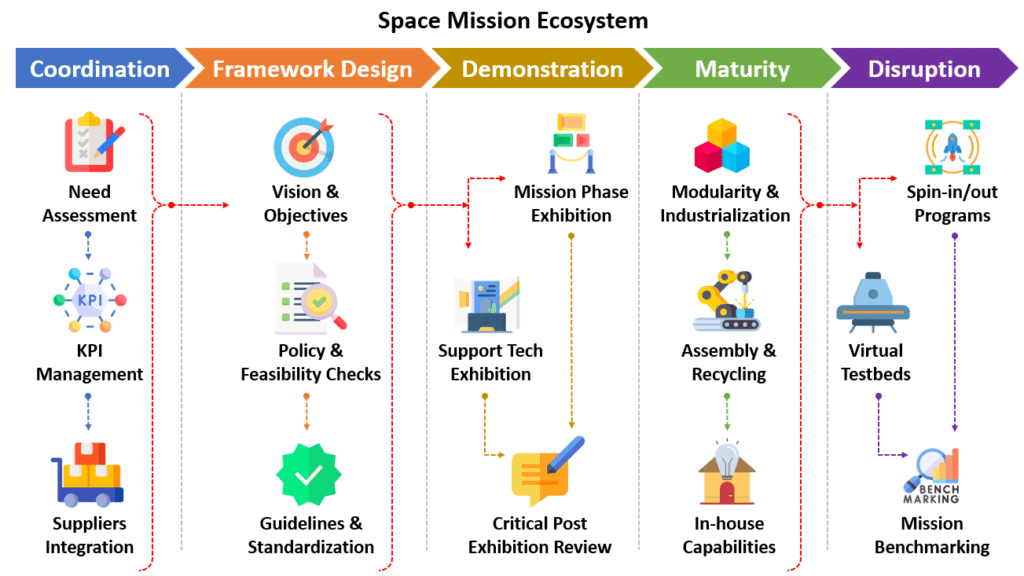
Overview:
While the concept of the low-budget space race is not new, it has garnered sustained attention, largely catalyzed by India’s modest-budget space powerhouse—the Indian Space Research Organization (ISRO). Over the past decade and in the current one, ISRO has achieved remarkable milestones in space exploration at a fraction of the cost when compared to its international counterparts. Whether it’s their record-breaking 104 satellite launches in a single mission, their successful missions to Mars and the Moon, or their consistent demonstration of technical prowess and cost-effectiveness, ISRO has become a global benchmark in efficient space endeavors.
In addition to commercial space travel, this space landscape, coveted by major developing and developed economies, has witnessed only a handful of successful entrants. In this article, we delve into the realm of low-budget space programs, snipping their budgetary intricacies and their profound impact on the space ecosystem. Additionally, we highlight some notable low-budget space initiatives and the remarkable space capabilities emerging from around the world.
Contents:
- What is a Low-Budget Space Program
- What is Zero-based Budgeting (ZBB)
- Space Mission Ecosystem of Low-Budget Space Programs
- Space Agencies and their Annual Budgets
- Space Agencies and Their Capabilities
- Notable Low-Budget Space Programs
- Summing Up
What is a Low-Budget Space Program:
As the name implies, low-budget space programs operate within limited financial allocations for various space missions. This emerging trend has had a contagious influence, inspiring the growth and motivation of both new and existing space agencies worldwide. Examples include the Australian Space Agency and the Brazilian Space Agency, which have embraced this cost-effective approach in recent times.
Among all the space agencies, ISRO stands out for its proactive pursuit of financial strategies that support its budgeting objectives. One notable mechanism it employs is Zero-Based Budgeting (ZBB).
So, what is Zero-based Budgeting (ZBB):
Zero-based budgeting (ZBB) is a budgeting method that involves creating a new budget from scratch for each period. Unlike traditional budgeting, which starts with the previous period’s budget and makes adjustments, ZBB justifies every expense anew. It allocates funds based on program efficiency and necessity, rather than relying on budget history. ZBB was pioneered by Peter Pyhrr in the 1970s, with its earliest implementation dating back to the 1960s at Texas Instruments. In India, it was first adopted by the Department of Science and Technology in 1983.
ISRO adheres strictly to zero-based budgeting as part of its financial management practices. Additionally, it predominantly sources supplies from local Indian companies, a strategy that contributes to cost-effectiveness and precise budget control within the Indian space agency.
Space Mission Ecosystem of Low-Budget Space Programs:
The space mission ecosystem remains consistent whether for low or high-budget space programs. Even in low-budget space programs, a rigorous check and seamless coordination among various industry partners are essential for a successful mission execution. The key distinction lies in the prioritization of individual segments or modules. Low-budget programs tend to focus on fundamental aspects and often employ strategies like combining split or bifurcated segments/modules to optimize time and resources efficiently.

Space Agencies and their Annual Budgets:
Previously, the prevailing belief was that only a substantial budget could ensure successful space missions. However, recent achievements in cost-effective space missions shattered this myth. This breakthrough ignited a space race driven by optimal pricing, intensifying competition among space agencies. As a result, many countries have begun to allocate additional funds for space-based budget experiments.
| Country | Space Agency Name | Annual Budget (In USD Million, Tentative) |
| United States | National Aeronautics and Space Administration (NASA) | 25,400 (FY23) and 27,200 (FY24) |
| China | China National Space Administration (CNSA) | 11,940 (FY23) |
| Europe | European Space Agency (ESA) | 7,100 (FY23) |
| Russia | Russian Federal Space Agency (ROSCOSMOS) | 3,420 (FY23) |
| France | National Centre for Space Studies (CNES) | 3,280 (FY23) |
| India | Indian Space Research Organization (ISRO) | 1,512 (FY23) |
| Germany | German Aerospace Center (DLR) | 1,356 (FY23) |
| Italy | Italian Space Agency (ASI) | 1,080 (FY23) |
| Japan | Japan Aerospace Exploration Agency (JAXA) | 1,060 (FY23) |
| Spain | Spanish Space Agency (AEE) | 753 (FY23) |
| South Korea | Korea Aerospace Research Institute (KARI) | 674 (FY23) |
| United Kingdom | UK Space Agency (UKSA) | 600 (FY23) |
| Canada | Canadian Space Agency (CSA) | 540 (FY23) |
| Ukraine | State Space Agency of Ukraine (SSAU) | 110 (FY23) |
| Brazil | Brazilian Space Agency (AEB) | 70 (FY23) |
| Australia | Australian Space Agency (ASA) | 34 (FY23) |
| Israel | Israel Space Agency (ISA) | 20 (FY23) |
| Iran | Iranian Space Agency (ISA) | 11 (FY23) |
Space Agencies and Their Capabilities (As of 2023):
The realm of space capabilities remains relatively limited, with only a handful of countries successfully launching satellites, sending space probes to celestial bodies such as the Moon or other planets, or conducting indigenous human spaceflights.
| Country | Space Agency Name | Indigenous Satellite Launch Capabilities | Indigenous Probe Sending Capabilities | Indigenous Human Spaceflight Capabilities |
| United States | National Aeronautics and Space Administration (NASA) | Yes | Yes | Yes |
| China | China National Space Administration (CNSA) | Yes | Yes | Yes |
| Europe | European Space Agency (ESA) | Yes | Yes | Yes |
| Russia | Russian Federal Space Agency (ROSCOSMOS) | Yes | Yes | Yes |
| France | National Centre for Space Studies (CNES) | Yes | —- | —- |
| India | Indian Space Research Organization (ISRO) | Yes | Yes | —- |
| Germany | German Aerospace Center (DLR) | —- | —- | —- |
| Italy | Italian Space Agency (ASI) | —- | —- | —- |
| Japan | Japan Aerospace Exploration Agency (JAXA) | Yes | Yes | —- |
| Spain | Spanish Space Agency (AEE) | —- | —- | —- |
| South Korea | Korea Aerospace Research Institute (KARI) | Yes | Yes | —- |
| United Kingdom | UK Space Agency (UKSA) | —- | —- | —- |
| Canada | Canadian Space Agency (CSA) | —- | —- | —- |
| Ukraine | State Space Agency of Ukraine (SSAU) | —- | —- | —- |
| Brazil | Brazilian Space Agency (AEB) | —- | —- | —- |
| Australia | Australian Space Agency (ASA) | —- | —- | —- |
| Israel | Israel Space Agency (ISA) | —- | —- | —- |
| Iran | Iranian Space Agency (ISA) | —- | —- | —- |
Notable Low-Budget Space Programs:
Chandrayaan-1:
Year: 2008
Project Cost: INR 386 Crore (USD 52 Million)
Status: Successful (Met Objectives)
Chandrayaan-1, part of the Chandrayaan program, marked India’s first lunar probe. Launched by the Indian Space Research Organization (ISRO) in October 2008, it operated until August 2009. The mission consisted of an orbiter and a Moon Impact Probe. The orbiter entered lunar orbit on November 8, 2008, while on November 14, 2008, the Moon Impact Probe separated from the Chandrayaan orbiter and intentionally impacted the Moon’s south pole at Jawahar Point.
This achievement made ISRO the fifth national space agency to successfully reach the lunar surface. The others were the former Soviet Union, the United States, Japan, and the European Space Agency (ESA).
Chandrayaan-2:
Year: 2019
Project Cost: INR 978 Crores (USD 96.5 Million)
Status: Partially Successful (Partially Met Objectives)
Chandrayaan-2, India’s second lunar exploration mission developed by ISRO, includes a lunar orbiter, the Vikram lander, and the Pragyan rover, all created domestically. Its primary scientific objectives are mapping and studying lunar surface composition variations, along with identifying the location and abundance of lunar water. Launched on July 22, 2019, the spacecraft entered lunar orbit on August 20, 2019. The mission achieved partial success due to the lander’s failure to make a soft landing on the Moon’s surface.
Chandrayaan-3:
Year: 2023
Project Cost: INR 615 Crores (USD 75 Million)
Status: Successful (Exceeded the Objectives)
Chandrayaan-3, the third mission in the Chandrayaan program by ISRO, launched on July 14, 2023. The mission includes a lunar lander named Vikram and a lunar rover named Pragyan, similar to those on Chandrayaan-2 in 2019, which achieved partial success. With Chandrayaan-3, India became the fourth country to successfully land on the Moon and the first to do so near the lunar south pole.
Mangalyaan:
Year: 2013
Project Cost: INR 450 Crores (USD 73 Million)
Status: Successful (Met the Objectives)
The Mars Orbiter Mission (MOM), also known as Mangalyaan, was an interplanetary space probe mission launched on November 5, 2013, by the Indian Space Research Organization (ISRO). This mission marked India’s debut in interplanetary exploration and earned ISRO the distinction of being the fourth space agency in the world to successfully achieve Mars orbit, following Roscosmos, NASA, and the European Space Agency.
Mangalyaan made India the first Asian nation to reach Mars’ orbit and the first country globally to do so on its maiden attempt. Notably, it was also the most cost-effective Mars mission ever, attributed to a modular approach, minimal ground tests, extended working hours by scientists, utilization of homegrown technologies, a simplified design, and a significantly less complex payload compared to its counterpart, MAVEN.
Aditya L1:
Year: 2013
Project Cost: INR 400 Crores (USD 48 Million)
Status: On Course
Aditya-L1 is a spacecraft equipped with specialized instruments, designed and developed by ISRO to investigate the solar atmosphere. Positioned in a halo orbit around the Earth-Sun L1 Lagrange point—omitting the Moon—Aditya-L1’s mission is to study the solar atmosphere, solar magnetic storms, and their impact on Earth’s environment. This marks India’s inaugural mission dedicated to solar observation.
Launched aboard the PSLV C57 on September 2, 2023, Aditya-L1 is slated to travel for 125 days, covering nearly 1.5 million kilometers on its journey to reach the Halo orbit around the L1 Lagrange Point.
Summing Up:
While several small to mid-range space projects have incurred costs exceeding USD 100 million, it’s worth highlighting the remarkable cost-effectiveness of Indian space projects in contrast. Take, for instance, Russia’s Luna-25 Moon mission, which carried a budget of approximately USD 150 million. Japan’s Moon Mission SLIM, on the other hand, surpassed the USD 470 million mark, and South Korea’s inaugural lunar probe, the Korea Pathfinder Lunar Orbiter (KPLO), amounted to around USD 180 million.
However, despite these substantial budgets, these projects were unable to match the level of cost-effectiveness consistently demonstrated by Indian space endeavors. India’s space agency, ISRO, has repeatedly achieved remarkable milestones in space exploration at significantly lower costs. This cost-efficiency has become one of ISRO’s defining characteristics, allowing them to maximize scientific and technological achievements while minimizing financial resources.











